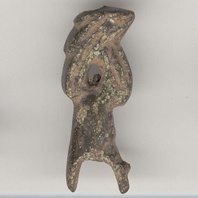
Viking Objects
Prick Spur (LIN-DC6E82)
Early spurs had a neck that ended in a point, called a prick, riveted to the heel band. This object is a fragment of the prick and is cylindrical in section. It is broken at the lowest point where it divides into two arms. There is a hollow shaft above leading into two decorative crescent-shaped arms, one arching over the other. Each arm is longitudinally ribbed. The very top of the object is also pierced, allowing something to pass vertically through the entire object.
Read More
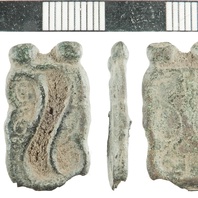
Viking Objects
Strap-End (NLM-E77782)
This copper-alloy strap-end fragment is classified as a Thomas Class B5 type and is decorated with wavy bilateral ornamentation which may show Carolingian influences. Strap-ends came in various styles and were fairly common throughout the Viking world. They were used to decorate the ends of belts and to stop them getting damaged.
Read More
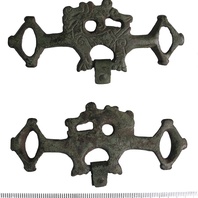
Viking Objects
Harness Fitting (LIN-7C2052)
This is either a harness fitting or strap distributor on which the central part is decorated with Ringerike-style ornament which was used for most of the eleventh century.
Read More
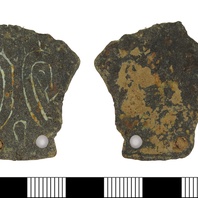
Viking Objects
Stirrup-Mount Fragment (LEIC-534DFF)
This copper-alloy stirrup-strap mount, classified as a variant of Williams Class A Type 1, is decorated with two sets of double curving incised lines that may represent beasts.
Read More
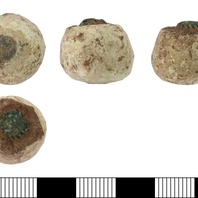
Viking Objects
Spherical Lead-Alloy Weight (DENO-650DB1)
This is a cast lead-alloy weight with a copper alloy Anglo-Saxon pin embedded in the centre. The base features a flattened copper alloy circular area that may be the worn remains of another embedded object. This piece demonstrates Anglo-Scandinavian reuse and repurposing of Anglo-Saxon metalwork. It has also been suggested that this item was a gaming piece although it does not resemble other known gaming pieces. Weights are an important form of evidence for Viking Age commerce and the use of standards across the different economic systems within which Vikings were integrated. Many of the weights discovered, particularly ones in Ireland and those of Arabic type, suggest that a standardized system of weights existed in some areas. These standard weights, alongside standard values of silver, are what allowed the bullion economy of Viking-occupied areas to function. A bullion economy was a barter economy that relied on the exchange of set amounts of precious metal in various forms, such as arm-rings or coins, for tradeable goods, such as food or textiles. Each merchant would have brought their own set of weights and scales to a transaction to make sure that the trade was conducted fairly.
Read More
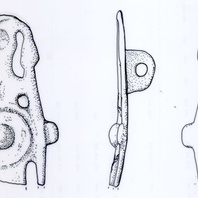
Viking Objects
Pendant (LEIC-C58A13)
This copper-alloy pendant depicts an individual holding a shield and a sword. Similar designs have been seen in pendants from southern Scandinavia which are generally identified as valkyries, though they could represent other mythological figures. The closest parallel in England is an example from Wickham Market, Suffolk. .
Read More
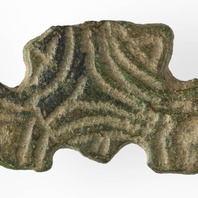
Viking Objects
Trefoil Brooch Fragment (CM.1823_2008)
A fragment of a Scandinavian copper-alloy trefoil brooch with a simple line pattern following its general outline. While of Scandinavian design, many examples found in the East Midlands were probably made in the Danelaw, and may have been copies of Scandinavian styles, instead of being imported from Scandinavia. For more information on Scandinavian jewellery in England check out our blog: Brooches, Pendants and Pins: Scandinavian Dress Accessories in England.
Read More
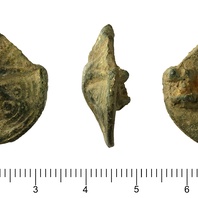
Viking Objects
Copper-Alloy Borre-Style Brooch (SWYOR-A257A6)
A Scandinavian copper-alloy Borre-style convex disc brooch decorated with three inward-looking Borre-style animal heads separated by wedge-shaped arms. Identified as Jansson type II A1 by Jane Kershaw. For more information on Scandinavian jewellery in England check out our blog: Brooches, Pendants and Pins: Scandinavian Dress Accessories in England.
Read More
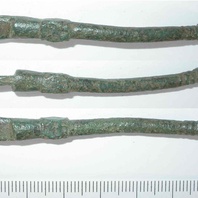
Viking Objects
Scale Arm Fragment (DENO-0619F7)
Folding balances of the type to which this arm belongs are known from the late Anglo-Saxon period and are quite common from the medieval period. The dating of this artefact is therefore somewhat problematic. Scales were a common commerical tool and would have been an important part of any exchange whether using a monetary system or a bullion system, such as the one that existed in Viking-occupied areas of England.
Read More
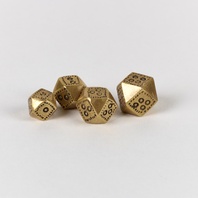
Viking Objects
Reproduction Polyhedral Weights
A group of four polyhedral weights of a type that is common throughout the Viking diaspora. This example has fourteen sides and four dots on each of the rectangular sides. These weights were adopted by the Vikings from Middle Eastern examples and appear to have become a de facto weight standard for traders.
Read More
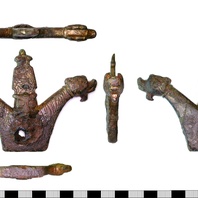
Viking Objects
Mystery Item
A gilded, copper alloy object that was clearly affixed to something else. The gilding shows that it was high status but its function remains a mystery.
